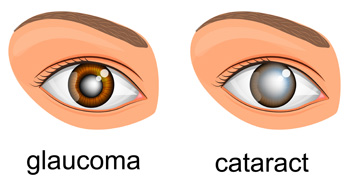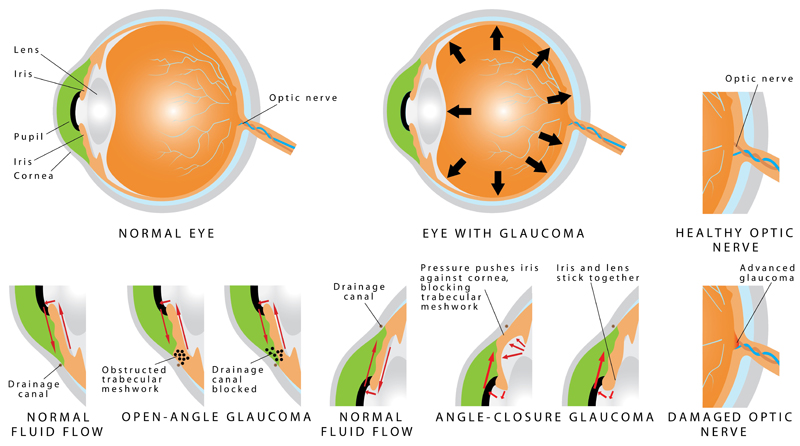Glaucoma Treatment & Surgery Options in Varanasi

Do Not Confuse Glaucoma with a Cataract

Many times it can be confused with a cataract which also manifests as a painless, gradual loss of vision. The difference is that in the case of cataract, the loss of vision is fully recoverable using a simple surgery called Phaco.
Our eyes contain a clear fluid called aqueous humor, which is continuously produced in the eye to bath and nourish the structures inside it. The fluid normally drains out of the eye through drainage canals in a fine meshwork located around the edge of the iris (the colored part of the eye that surrounds the pupil). In people with glaucoma, the fluid fails to drain due to some defect and thus increases the pressure inside the eyes called raised Intraocular Pressure (IOP) (or Tension).
Who Is At a Risk of Glaucoma?
Anyone can develop glaucoma. Some people are at higher risk than others. They include:
- Everyone over the age of 40 yrs.
- People with family history of glaucoma.
- People with near sightedness (Myopia) for open angle type and far sightedness (hyperopia) for close angle type
- People with Diabetes
- People with Hypertension
- People with Migraines
Common Symptoms of Glaucoma
In most cases of glaucoma, the patient is not aware of the gradual loss of sight until vision is significantly impaired. However, if glaucoma progresses without adequate treatment, the following symptoms may occur in some individuals:
- Pain around the eyes when coming out from darkness (e.g., as soon as the person comes out of a cinema hall)
- Colored halo rings seen around light bulbs especially in the mornings and nights
- Frequent change of reading glasses, headaches, pain, and redness of the eyes
- Reduced vision in dim illumination and during nights
- Gradual decrease of side vision with the progression of glaucoma
Types of Glaucoma

Open-Angle Glaucoma
It happens when the eye’s drainage canals become clogged over time. The inner eye pressure (also called intraocular pressure or IOP) rises because the correct amount of fluid can’t drain out of the eye. With open-angle glaucoma, the entrances to the drainage canals are clear and open. The clogging problem occurs further inside the drainage canals, similar to a clogged pipe below the drain in a sink. Most people have no symptoms and no early warning signs. If open-angle glaucoma is not diagnosed and treated, it can cause a gradual loss of vision. This type of glaucoma develops slowly and sometimes without noticeable sight loss for many years. It usually responds well to medication, especially if caught early and treated. This form of glaucoma is more common in Caucasians than others.
Angle-Closure Glaucoma
This type of glaucoma is also known as acute glaucoma or narrow-angle glaucoma. It is more common in Asians and is very different from open-angle glaucoma in which the eye pressure usually rises very quickly. It happens when the entrance to the drainage canals is very narrow or covered over, like a sink with something covering the drain. Symptoms of angle closure glaucoma may include headaches, eye pain, nausea, rainbows around lights at night, and very blurred vision.
Congenital Glaucoma
Children are born with a defect in the angle of the eye that slows the normal drainage of fluid. These children usually have visible symptoms, such as cloudy eyes, sensitivity to light, and excessive tearing. Conventional surgery typically is the suggested treatment, because medicines may have unknown effects in infants and be difficult to administer. The operation is safe and effective. If surgery is done promptly, these children usually have an excellent chance of having good vision.
Secondary Glaucoma Types
These can develop as complications of other medical conditions. These types of glaucoma are sometimes associated with eye surgery or advanced cataracts, eye injuries, certain eye tumors, or uveitis (eye inflammation). Pigmentary glaucoma occurs when pigment from the iris flakes off and blocks the meshwork, slowing fluid drainage. A severe form, called neovascular glaucoma, is linked to diabetes. Corticosteroid drugs used to treat eye inflammations, and other diseases can trigger glaucoma in some people. Treatment includes medicines, laser surgery, or conventional surgery.
Low-Tension or Normal-Tension Glaucoma
In this type of glaucoma, the optic nerve is damaged even though intraocular pressure (IOP) is not very high. Lowering eye pressure by at least 30 percent through medicines slows the disease in some people. A comprehensive medical history is essential in identifying other potential risk factors, such as low blood pressure, that contribute to low-tension glaucoma. If no risk factors are identified, the treatment options for low-tension glaucoma are the same as for open-angle glaucoma.